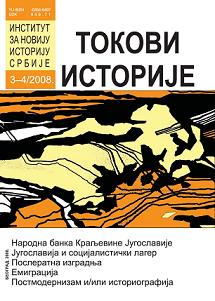„ПЛАТНЕНИ ГРАД“ ЈУГОСЛОВЕНСКИХ ИЗБЕГЛИЦА. ЈУГОСЛОВЕНСКИ ИЗБЕГЛИЧКИ КАМП У ЕЛ ШАТУ, 1944–1946.
„The Town of Linen“ of Yugoslav Refugees: Yugoslav Refugee Camp, El Shatt M. E. F. Egypt 1944–1946
Author(s): Sanja Petrović TodosijevićSubject(s): History
Published by: Institut za noviju istoriju Srbije
Keywords: Refuge;„partisan connection“; Southern Italy; Northern Africa; Egypt; El Shatt; Allied command;„kraljevci“
Summary/Abstract: The article is an attempt to draw attention, on basis of available archival sources and literature, to the fate of over 30.000 Yugoslav, i.e. Dalmatian refugees who had left their homes fearing German revenge in late 1943. Thanks to the „partisan connection“ most of the refugees were transferred via Vis and Southern Italy to Northern Africa and Egypt. The author’s attempt at getting insight into the perception of the African continent (which was just a geographic notion or a voice from afar for most refugees) showed that most members of the refugee community, comprising mostly children, women and the elderly, had mixed feelings about it. Filled with „fear of Africa“, but also fearing for their lives, not only of their own free will but also led by decisions which seemed „a good political solution at that time,“ most of the refugees could only board Allied vessels and go on a journey. Finding themselves in the middle of the whirlpool of mili tary, but also of complicated political circumstances, they became not infrequently, means of achieving certain “higher“ aims. Ideological work was intertwined with all aspects of life of the Yugoslavs who had temporarily settled down in Egypt. With the end of WWII conditions were ripe for the refugees to go home. The last group returned to the country in March 1946.
Journal: Tokovi istorije
- Issue Year: 2008
- Issue No: 3-4
- Page Range: 117-140
- Page Count: 24
- Language: Serbian

